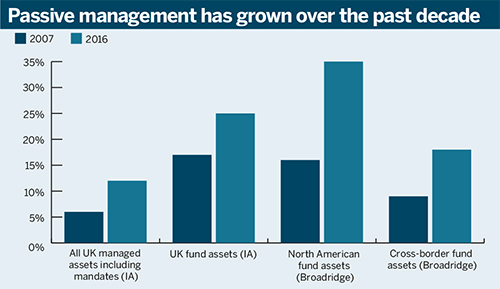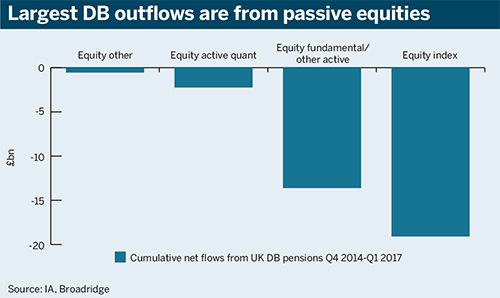Magnus Spence looks at how the industry needs to reconsider the distinction between active and passive
We need to stop using an unhelpfully binary active versus passive distinction.
The long-term trend is for the proportion in passive to grow – in many markets it has doubled in the past decade.
The neat distinction between passive and active assets is starting to look increasingly difficult to draw
Currently, about 12 per cent of UK fund assets are passively managed, according to the latest Investment Association survey, and this has doubled from 6 per cent since 2007. The IA says total UK managed assets including mandates have grown to more than 25 per cent today, from 17 per cent in 2007.
This doubling of the proportion in passive is evident in other markets. According to Broadridge GMI data, the North American fund market, which consists of €15tn (£13.2tn), is now 35 per cent passive, from 16 per cent in 2007.
The cross-border fund market, which combines €4tn of Ucits managed on behalf of clients in Europe and elsewhere in the world, is now 18 per cent passive, up from 9 per cent in 2007.


It is not easy to say exactly how much is invested passively in UK pensions today. The IA tells us that 38 per cent of pension fund mandates are passive, compared with 33 per cent of all UK mandates.
We believe that 24 per cent of UK defined benefit equity assets, including both funds and mandates, are in passive instruments. The equivalent proportion in UK defined contribution is much higher at 44 per cent.
In the US the pensions proportions are the other way round; North American DB pension plans’ investment in funds (ie excluding mandates) is 51 per cent passive, according to Broadridge GMI data. In contrast, only 28 per cent of the assets in 401(k) plans are passive.
Measuring index investment is not easy – the neat distinction between passive and active assets is starting to look increasingly difficult to draw. This is particularly true in the institutional space.
How do you disentangle between passive and active within the huge liability-driven investment allocation that exists within UK pensions in particular? How do you define smart beta, since it is designed to sit somewhere between active and passive?
How do you define multi-asset funds which have large passive components, or indeed those with just small amounts of passive within their portfolios? How do you draw the distinction between exchange traded funds and traditional passive vehicles?
There is no such thing as passive
 You don’t have to be living in one of Philip K Dick’s paranoid sci-fi dystopias to wonder if passive approaches are all they are cracked up to be.
You don’t have to be living in one of Philip K Dick’s paranoid sci-fi dystopias to wonder if passive approaches are all they are cracked up to be.
What exactly does a passive bond portfolio look like? And what do you mean by active and passive, when, for example, the asset allocation within predominantly passive portfolios is often actively managed?
When you look beneath the surface of these terms, much more interesting stories lurk. Broadridge’s Money in Motion has tracked a cumulative net total (inflows less outflows) of £36bn in third-party managed equity holdings flowing from UK DB pension schemes as they derisk between the final quarter of 2014 and the first quarter of this year.
But of this £36bn, £19bn is in index vehicles, which you might think were growing. The main equity sub-class that has leaked the least is active quantitative equity, which many will think is unexpected. The story is clearly much more nuanced than is allowed for in using a simple two-way split between active and passive.
Magnus Spence is managing director of research company Spence Johnson, a Broadridge company














